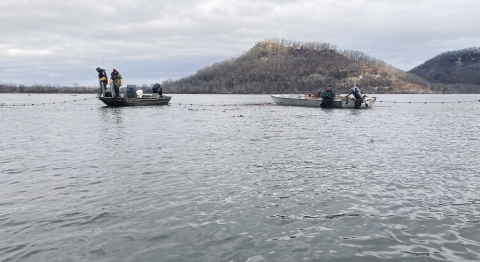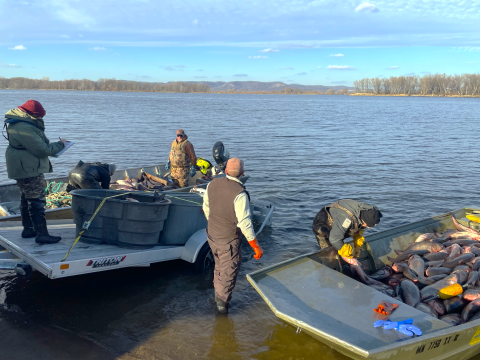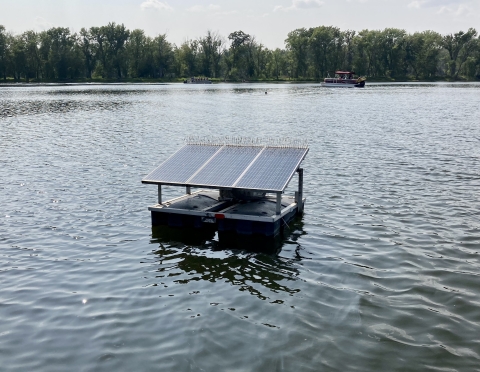Trempealeau (WI), The wind bites, the water is cold, and 30lb bighead, silver, and grass carp are being pulled out of nets in Pool 6 of the Upper Mississippi River. Never before have so many harmful, invasive carp been caught in this area. Invasive carp are notoriously hard to catch but this time, biologists knew right where they were. Why? Because the fish told them where they were. The use of acoustic telemetry is working and was the driving force for the successful removal of a record number of invasive carp in Pool 6 of the Upper Mississippi River. Using acoustic telemetry turns the search for invasive carp from looking for a needle in a haystack to aiming at a bullseye. One of the biggest challenges biologists face when using this method to track invasive carp movement is that people often unknowingly remove, displace, or destroy the telemetry receivers installed in the river that are at the frontier of fighting the invasion of carp in one of the largest rivers of North America.
It all begins with surgery on a fish
Throughout the year biologists catch carp, and once caught, crews anesthetize the fish before surgically implanting an acoustic transmitter. Afterwards the surgical site is closed with sutures and the fish is returned to the river. Acoustic receivers are placed at different locations along the Mississippi River, and as an invasive carp with an implanted transmitter passes a receiver, the time, date, and transmitter number are instantly collected and stored on the receiver. Due to the dynamic nature of rivers, these receivers may be placed in different spots or look different to accommodate different river conditions.
The traitor fish leads the way
Invasive carp congregate in larger groups during the fall, making it the ideal time of the year to focus removal efforts because you can capture the largest number of fish in a single sampling event. How do biologists find a group of invasive carp in the largest river in North America? Using acoustic telemetry data, of course. When you find the location of a fish you tagged, it could lead you to those larger groups of carp. Thus, the fish is named a traitor fish.
That’s exactly what happened on November 30th 2023, when 323 invasive carp were removed by commercial anglers, Minnesota DNR, and Wisconsin DNR. It’s where the data told them to go. The roots of these efforts started in 2020-2022 in Pools 15-19 where the traitor fish were first tagged. Biologists observed the fish swimming north during the major flooding of spring 2023, which allowed the dams between pools to become passable. In October 2023, biologists started noticing fish congregating in large numbers, which helped identify where exactly to set the nets that led to the removal of a record number of invasive carp.
People unknowingly obstruct progress to remove invasive carp
The acoustic telemetry receivers installed in the river to track invasive carp movements can only do their job if they remain in the water and undisturbed. An ongoing issue biologists face is that the telemetry receivers are routinely removed, displaced, or even destroyed. Replacing receivers is costly and more importantly, disturbing them works against the goal of removing invasive carp from the Mississippi River. If you happen to find an acoustic telemetry receiver, please do not disturb it. If you happen to find one out of the water make sure you throw it back in the river so it is fully submerged under the water. The use of acoustic telemetry technology is a critical piece in the fight against the carp invasion in the Mississippi River. You can assist these efforts by making sure our acoustic telemetry equipment remains intact.
Take a look at the pictures below that show tags used to identify telemetry equipment and telemetry receivers. If you find something in the river with this tag or that looks like this, please do not remove.






